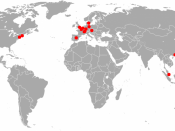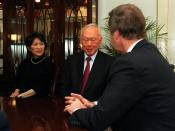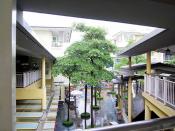S. Rajaratnam delivered the speech "Singapore: Global City" when Singapore, freshly independent, became enmeshed in overwhelming uncertainty, even of survival. Faced with the collapse of its economy's traditional pillars-loss of reliance on Malaysian hinterland; stymied trade with China due to Chinese political changes, and British military withdrawal�, Singapore was in the crucial process of reorienting her economy. Nonetheless, Rajaratnam was confident of Singapore's future economic success, and made the speech to answer critics who questioned Singapore's survival.
While Rajaratnam, then Singapore's Foreign Minister, may be inherently biased in presenting an overly optimistic view to boost people's morale, he balanced his perspective by acknowledging that, firstly, Singapore fundamentally depended on the global economy owing to her inherent territorial constraints and, secondly, that her survival as a Global City was not guaranteed but rather hinged on her ability in building "necessary capacities" � to manage political and social risks in the rapidly-developing international system.
Firstly, Rajaratnam pointed out that Singapore should "plug into"� the international system through links with multinational corporations, historical commercial ties with the West, and international communications and financial networks, making the world her hinterland�, as the alternative is "certain ruin"�. Rajaratnam's confidence in his assertions may be attributed to his understanding of the Global City as "a child of modern technology"�. In other words, he was predicting that larger international circumstances, including technological advancements, would support Singapore's development into a Global City, reflecting that Singapore's economic viability would be chiefly driven by larger regional/international forces. Indeed, Singapore's subsequent survival was made possible by international forces in the late-1970s-rapid development of manufacturing, telecommunications and transportation technologies, and favorable political and ideological environment�-which enhanced global connectivity, hence supporting Singapore's viability as a Global City.
Secondly, Rajaratnam recognized that Singapore as a Global City may encounter political...


